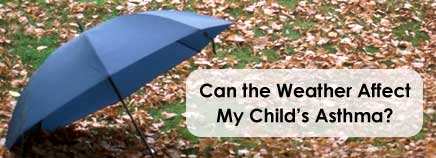
Weather and Asthma
The effect of weather on asthma symptoms isn’t fully understood, but clearly there is a link. Numerous studies have shown a variety of connections, such as increases in asthma-related emergency department visits when certain weather conditions are present. Some people find that their asthma symptoms get worse at specific times of year. For others, a severe storm or sudden weather change may trigger an attack.
Exposure to cold, dry air is a common asthma trigger and can quickly cause severe symptoms. People with exercise-induced asthma who participate in winter sports are especially susceptible. Dry, windy weather can stir up pollen and mold in the air, leading to problems for some people.
Hot, humid air also can trigger asthma symptoms, and wet weather encourages the growth of mold spores, another asthma trigger. In certain areas, heat and sunlight combine with pollutants to create ground-level ozone, which is also an asthma trigger.
Studies have shown that thunderstorms can trigger asthma attacks. One study showed that during thunderstorms, the daily number of emergency department visits for asthma increased by 15%. The study concluded that the problem was caused by the number of fungal spores in the air, which almost doubled. It wasn’t rain, but the wind, that caused this increase. Changes in barometric pressure may also be an asthma trigger.
Avoiding Allergy Triggers
If you suspect weather is playing a role in your child’s asthma, keep a diary of asthma symptoms and possible triggers and discuss them with your doctor.
Once you know what kind of weather triggers asthma symptoms, try these tips to protect your child:
- Watch the forecast for pollen and mold counts as well as other conditions (extreme cold or heat) that might affect your child’s asthma.
- Limit your child’s outdoor activities on peak trigger days.
- Make sure your child wears a scarf over his or her mouth and nose outside during very cold weather.
- Keep windows closed at night to keep pollens and molds out. If it’s hot, use air conditioning, which cleans, cools, and dries the air.
- Keep your child indoors early in the morning (before 10 AM) when pollen is at its highest levels.
- Your child shouldn’t mow the lawn or rake leaves, and should be kept away from freshly cut grass and leaf piles.
- Dry clothes in the dryer (hanging clothes or sheets to dry can allow mold or pollen to collect on them).
- Make sure your child always has quick-relief medicine (also called rescue or fast-acting medicine) on hand.
Your child’s written asthma action plan should list weather triggers and ways to manage them, including any seasonal increases in medication. A child whose asthma seems to be allergy-related may also need to see an allergist for medication or allergy shots.

